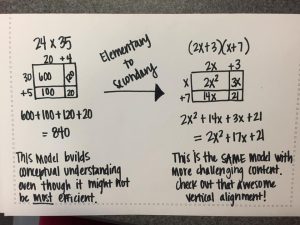Falling back in love with math

 Parents around the country have expressed trepidation about new math instruction they don’t recognize and rightful concern that they are unable to help their children with their homework. But, some parents have come to the realization that they want their children to be better and more confident at math than they were as students. And the more they learn, the more parents are starting to appreciate the math concepts promoted in the Common Core State Standards.
Parents around the country have expressed trepidation about new math instruction they don’t recognize and rightful concern that they are unable to help their children with their homework. But, some parents have come to the realization that they want their children to be better and more confident at math than they were as students. And the more they learn, the more parents are starting to appreciate the math concepts promoted in the Common Core State Standards.
Here’s what some parents recently told Washington Post’s Jay Mathews when asked their thoughts on Common Core math:
“Like many parents in the early years, we were confused by the math in particular and not very supportive…[But now my twin daughters] understand math concepts so completely after learning ‘that crazy way’ in elementary school that I am a huge believer. They reason and understand. They do not memorize and move on.” – Maryland parent, Marianne Sullivan
“My first reaction to a Common Core worksheet was repulsion. It’s ugly math. It doesn’t look pretty or easy… [But] I set that aside and learned how to do what he was doing. And something magical happened: I started doing math better in my head.” – Washington State parent and tutor, Hadley Danielson
Certainly, not all material should be new to parents. Common Core State Standards still require students to know basic procedures and traditional problem-solving methods. Zimba explains in a piece this month, but the standards also encourage having kids learn multiple approaches to solving math problems so that they can choose the approach that works best for them, and so that they develop a full understanding of the concepts before they move on to more challenging levels.
This Facebook post from an Idaho teacher demonstrates exactly how that complete understanding translates to making more complex math concepts easier for students to grasp:
“We whipped through this in a day because they were able to conceptually understand the idea of splitting the area of a rectangle into easier to compute pieces, and then finding the sum of the pieces. Is this method the most efficient for multiplying simple two digit numbers? Probably not. But is there a PURPOSE for exposing students to this kind of thinking early on? Totally! … I just love seeing Common Core working!”
About the Collaborative for Student Success
At our core, we believe leaders at all levels have a role to play in ensuring success for K-12 students. From ensuring schools and teachers are equipped with the best materials to spotlighting the innovative and bold ways federal recovery dollars are being used to drive needed changes, the Collaborative for Student Success aims to inform and amplify policies making a difference for students and families.
To recover from the most disruptive event in the history of American public schools, states and districts are leveraging unprecedented resources to make sure classrooms are safe for learning, providing students and teachers with the high-quality instructional materials they deserve, and are rethinking how best to measure learning so supports are targeted where they’re needed most.




